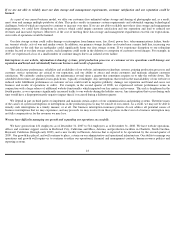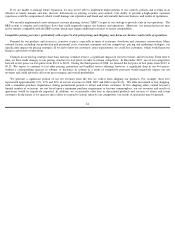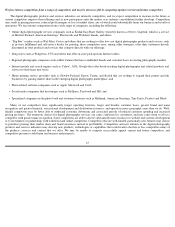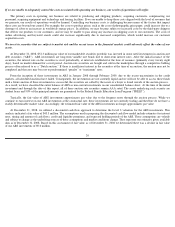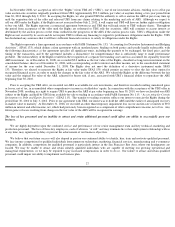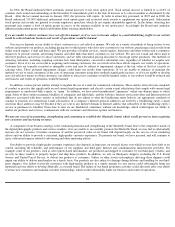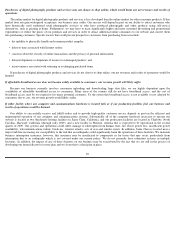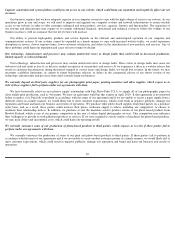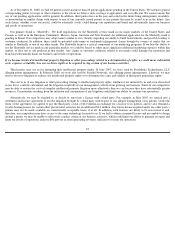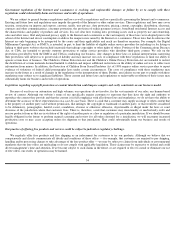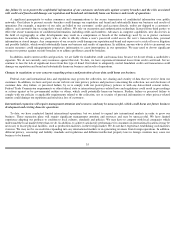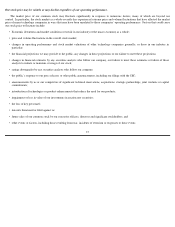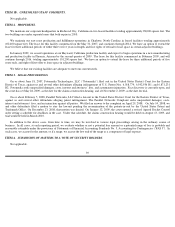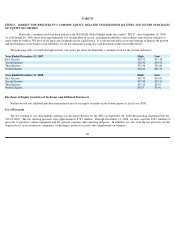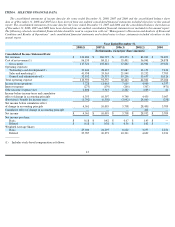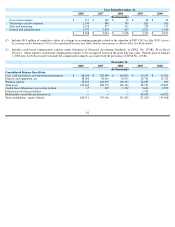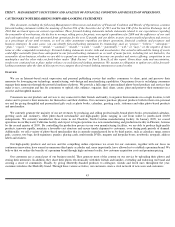Shutterfly 2009 Annual Report Download - page 35
Download and view the complete annual report
Please find page 35 of the 2009 Shutterfly annual report below. You can navigate through the pages in the report by either clicking on the pages listed below, or by using the keyword search tool below to find specific information within the annual report.
The inability to acquire or maintain domain names for our website could substantially harm our business and results of operations.
We currently are the registrant of the Internet domain name for our website, Shutterfly.com, as well as various related domain names.
Domain names generally are regulated by Internet regulatory bodies and are controlled also by trademark and other related laws. The regulations
governing domain names could change in ways that block or interfere with our ability to use relevant domains. Also, we might not be able to
prevent third parties from registering or retaining domain names that interfere with our consumer communications, or infringe or otherwise
decrease the value of our trademarks and other proprietary rights. Regulatory bodies also may establish additional generic or country-code top-
level domains or modify the requirements for holding domain names. As a result, we might not be able to acquire or maintain the domain names
that utilize the name Shutterfly in all of the countries in which we currently or intend to conduct business. This could substantially harm our
business and results of operations.
We may be subject to past or future liabilities for collection of sales and use taxes, and the payment of corporate level taxes.
Our policies concerning the collection of sales and use taxes and the payment of certain corporate level taxes have been based upon
decisions of the U.S. Supreme Court that determine when a taxpayer is deemed to have nexus with a state sufficient to impose tax obligations
under the Commerce Clause of the U.S. Constitution. Those Supreme Court decisions require that the taxpayer be physically present before a
state can require the collection of sales and use taxes. States are currently attempting to expand the definition of what constitutes physical
presence for sales and use taxes. At the same time, the standard governing the imposition of other taxes, for instance, corporate income taxes, is
less established and a number of state courts have recently concluded that the Commerce Clause definition of nexus should be expanded to
include either “physical” or “economic”
presence (essentially marketing activities) which is a broader definition than is used for sales and use
tax.
In reliance upon the U.S. Supreme Court’
s decisions, we have continued to collect sales and use taxes in California, Nevada, Pennsylvania,
North Carolina, New York, New Jersey, Arizona and Minneapolis where we have employees and/or property. Starting in June 2007, we also
began collecting sales and use taxes in other states where we have implemented joint sales efforts with Target Corporation.
While we believe the U.S. Supreme Court decisions support our policies concerning the collection and payment of taxes, tax authorities
could disagree with our interpretations. If sustained, those authorities might seek to impose past as well as future liability for taxes and/or
penalties. Such impositions could also impose significant administrative burdens and decrease our future sales. Moreover, the U.S. Congress has
been considering various initiatives that could limit or supersede the U.S. Supreme Court’s position regarding sales and use taxes.
Our effective tax rate may be subject to fluctuation from federal and state audits, and disqualifying dispositions of stock options.
Future tax audits by taxing agencies for the open tax years could lead to fluctuations in our effective tax rate because the taxing authority
may disagree with certain assumptions we have made regarding appropriate credits and deductions in filing our tax returns.
Under current stock option tax regulations, we are entitled to a stock option compensation tax deduction when employees exercise and sell
their incentive stock options within a two year period for a taxable gain. Our current effective tax rate estimate does not incorporate this
deduction as the extent of the deduction, based on employee option disposition activity is not currently determinable. These disqualifying
dispositions could lead to future fluctuations in our effective tax rate for any given quarter or year.
33


